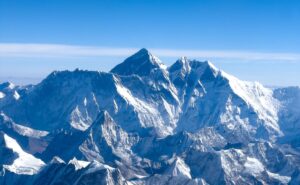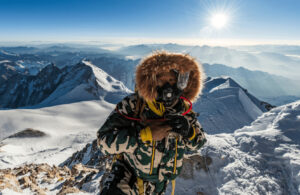This week, Nepali media quoted a committee of experts — including local geographers and climbers (connected to outfitters) — suggesting that there are several more 8,000m peaks than the commonly accepted 14.
Some in Nepal’s tourism industry have been trying to gain official acceptance of this idea for over a decade. Yet the truth is not as sensational as it seems. These sources have not discovered long-overlooked peaks in remote corners of the Himalaya. These six “new” Nepal 8,000’ers on their list are subsidiary summits of the main peaks, according to globally accepted definitions. But it raises an interesting question: How do you tell a sub-summit from an independent peak?
The “new” challenges
The Nepalis enlarged the classical list of 8,000m peaks to include four secondary summits of Kangchenjunga — no wonder its name translates as “the five treasures of the great snows” — and two points on Lhotse: Lhotse Middle (8,413m) and Lhotse Shar (8,400m).
Ultimately, the question turns around the definition of a mountain. If we were really flexible, we could add even more peaks to the 8,000m list. The team at 8000ers.com has compiled a complete list of 8,000m subsidiary peaks, a few facts about them, and the first time they were summited. A few, in fact, have yet to see a first ascent.

8000ers.com‘s list of the main 8,000m subsidiary peaks, with columns on altitude, prominence (P), dominance (D), and elevation units (EU).
According to 8000ers.com, Lhotse has not two but six separate points above 8,200m — four of them still unclimbed. The Kangchenjunga massif features five secondary points. And Everest and Annapurna also feature sub-summits.
Under the same criteria, there would be extra 8,000’ers in Pakistan: K2 has an 8,580m southwest peak, plus a second point at 8,134m on the Southwest Ridge, typically considered a subsidiary summit. Same with Nanga Parbat’s south peak (8,042m). Yet the most identifiable of all is Broad Peak Central (8,011m), which is considered a “relatively independent Main Peak.”
8000ers.com: they’re all no-mountains
8000ers.com’s Eberhard Jurgalski told ExplorersWeb that the listed subsidiary peaks would make interesting climbing but that they are not independent peaks.
“The higher subsidiaries are quite interesting because of their remarkable heights, but of course, they remain ‘no-mountains,’ just subsidiary peaks,” Jurgalski said. “Kangchenjunga West (8,077m) is even more subsidiary, but still unclimbed, so it is an interesting [challenge for climbers]. But it is definitely not an additional mountain.”

The Kangchenjunga traverse, as planned by Simone Moro and Tamara Lunger in 2017. Photo: GoreTex website
Some are reluctant to abandon the dream of having several other 8,000m peaks up which to guide clients. The Kathmandu Post claims that Kangchenjunga West, also known as Yalung Kang, was “accepted” as 8,000’er number 15 in 2014 and opened to foreign expeditions. “But the international mountain fraternity has been holding back endorsing it,” it admits.
Buddhi Narayan Shrestha, former department director of Nepal’s national mapping organization, argues that Kangchenjunga West’s status as an independent peak has been demonstrated “by several studies.” He complained that the “Nepal Government was hesitant to proclaim it.”
Nor were advocates lucky with the UIAA (the Swiss-based Union of International Alpinism Associations), where they have taken their case on several occasions.
Distance, prominence, and dominance
Which criteria decide what is a subsidiary and what is an independent peak? In this case, Nepal has different criteria from others.
“A mountain is normally considered a separate peak if the col distance between two peaks, the lowest point on the ridge, is at least 500 meters, and if the peak has a separate route not shared with any other peak,” Ang Tshiring Sherpa, former president of the Nepal Mountaineering Association, told The Kathmandu Post.
However, the generally accepted parameters for an independent mountain, from the Alps to the Andes to the Himalaya, are not based on the distance between peaks. Rather, it depends on a peak’s topographical features, especially its prominence: the elevation of a summit relative to its surrounding terrain, according to the U.S. Geological Survey. In its research to list the Alps’ 4,000’ers and the Pyrenees’ 3,000’ers, the UIAA defined prominence as the vertical distance between a mountain’s summit and the lowest contour line encircling it but containing no higher summit within it.

Topographic isolation and prominence of ‘B’.
The UIAA required a 30m drop, plus some other characteristics, to include a mountain in the Alps as an autonomous 4,000m peak. Peakbagger.com’s list of U.S. 14,000’ers requires 300 feet of clear prominence for each peak. In the Himalaya, it often depends on the author. Read a history of prominence by 8000ers.com here.
Richard Goedeke’s book The Alpine 4000m Peaks by the Classic Routes includes a classification of summits, peaks, and independent mountains according to prominence and measured in EU (elevation units, shown in the 8000ers.com table above). Each EU corresponds to 30m, a classic rope length in the Alps. It is widely used for peaks over 4,000m.
“All points with a notch depth greater than 30m were thus considered as ‘minor sub-peaks,'” the book asserts. “If the notch depth exceeded 60m or two classic rope lengths, the term ‘major sub-peak’ was used…An independent mountain would need to have ten classic rope lengths (300m) to the col.”
Subjective factors
Prominence is not the only factor that helps classify mountains. The UIAA also applies some subjective criteria. Occasionally, it has granted the “mountain” designation to peaks with modest prominence but high mountaineering interest or distinctive features — a highly technical pinnacle, for example, or a challenging gap between it and the main peak.
In addition, 30 vertical meters are not the same on a 4,000m peak and on a Himalayan giant. Several authors have applied different criteria and contributed to expanding the debate.

Mount Everest, the highest of them all. Photo. Wikipedia
Recently, a third criterion has become common: orographic dominance. This is the ratio, expressed in percentage, between the total height of the mountain and its prominence.
Orographic dominance classifies the Andes 6,000’ers, for example. Here, the orographic dominance must be over 7% for the main peak, between 2.1% and 6.99% for a subsidiary peak, and between 0.7% and 2.99% for a secondary summit, according to Estilo Alpino. For a thorough technical explanation, read a long study on orographic dominance by 8000ers.com.
The debate about subsidiary peaks vs independent mountains pops up from time to time among topographers, explorers, and climbers. It is, for instance, a recurrent headache when climbers search for the “highest unclimbed peak.” This is commonly — though not unanimously — granted to Pakistan’s Muchu Chhish. Controversy remains because Muchu Chhish, part of the Batura Range, has just 263m of prominence and 3.5% dominance.

Manaslu and its East Pinnacle are NOT two independent peaks. Photo: Simone Moro
That is also why Manaslu’s very characteristic Pinnacle, which is 7,992m, is not included on any list. It just has 121 meters of prominence and 1.4% dominance.
Of those six new 8,000’ers proposed by Nepali experts, none has enough prominence or dominance to be an independent mountain.
A tourism promotion strategy
You may ask, why should prominence and dominance be the proper criteria rather than the distance-based parameters of Nepali experts? Well, there is no law that places one above the other. But a game with as few rules as mountaineering must sometimes come to a consensus. Such an agreement defines the ultimate high-altitude challenge as the 8,000m peaks. The list could just as easily have evolved as all peaks above 25,000 feet (7,600m). This would have made outfitters (and a few countries) happy because it would have included many more mountains.
Ang Tshiring Sherpa admits that the Nepalis have a clear objective: “We have been consistently lobbying for international recognition of these six mountains that will boost our tourism,” he said.
No one prevents them from offering expeditions to subsidiary peaks of the 8,000’ers. For those willing to dare these sometimes difficult climbs and are ready to pay the climbing fees, it is a novel option. But it is unlikely that the ranks of the official 8,000’ers will increase any time soon.






